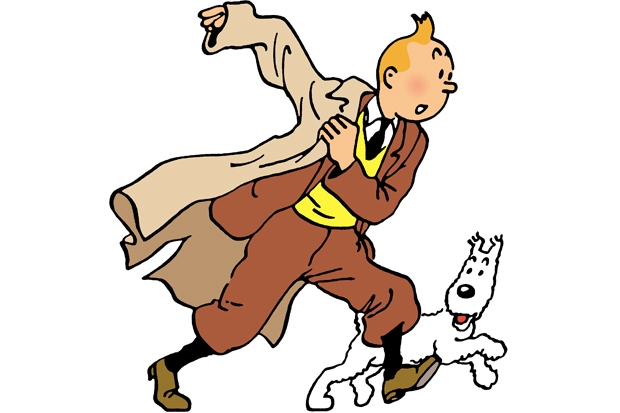Reading Tintin when I was a child, in Britain in the 1970s, I always assumed Georges Remi’s creation was just a harmless bit of fun. However, when I went to Belgium I discovered, to my amazement, that over there they take him very seriously indeed (this year, a single Tintin picture sold for €2.5 million in Brussels). In Britain, the fearless reporter in the plus fours is a quaint juvenile amusement. In his native Belgium he’s seen as high art, and his creator Hergé (Georges Remi’s initials, backwards) is revered.
The late Harry Thompson wrote a brilliant book about Tintin from the British perspective. It was informed and affectionate, but stopped short of adulation. Pierre Sterckx’s bulkier book belongs in the Continental camp. It’s designed to sit alongside proper monographs, not children’s comics. It’s no surprise that Sterckx’s credits include a book about Vermeer.
To be fair, Sterckx knows his stuff, and his sources could hardly be better: he was close friends with Hergé from 1965 until his death in 1983. A curator and art historian, he taught Hergé about fine art (the chapter on Hergé’s art collection is particularly interesting — I never knew he collected Lichtenstein).
Sterckx clearly knows Hergé inside out, so why does his scholarly prose feel so detached? There are some intriguing insights into the origins of Hergé’s style, his use of monochrome and his debt to Chinese brushwork, but I yearned for more personal revelations. His two marriages, his depressions, his difficulties during (and after) the second world war — all these fascinating incidents are dismissed with frustrating brevity. Sterckx must have enough first-hand info to write a fine memoir about this elusive, enigmatic man, but his lavish tome is more primer than proper biography, which is a pity.
Never mind. The illustrations are beautiful, and there are lots I’ve never seen before, mostly from the snazzy Hergé Museum in Belgium: not only Tintin, but all sorts of ephemera, from adverts to portraits. These images are far more revealing than Sterckx’s quasi academic commentary. Tintinologists tie themselves in knots trying to justify Hergé’s war record, but his cartoons from the 1930s show he was no Nazi. Sterckx says he was a liberal, but above all he was a dreamer who wanted to be left alone. He loved being a boy scout and Tintin allowed him to carry on being a boy scout throughout his life.
So was Hergé an artistic genius or just a gifted draughtsman? Whose assessment is more accurate, the Belgians’ or the Brits’? Much as I adore Hergé, I can’t quite go along with Sterckx, who likens him to van Gogh and Cézanne. Even so, there is something about Tintin that sets it apart from other comics, even Asterix.
So what makes Hergé unique? Well, his pictures are a stunning blend of simplicity and complexity, but above all he was a superb storyteller, whose absurd, enchanting characters bear comparison with Waugh or Wodehouse. He’s part of a picaresque tradition that stretches back to Cervantes (Sterckx also cites his fondness for Alexandre Dumas, Mark Twain and Jerome K. Jerome).
Hergé’s clear, clean lines inspired countless grown up artists, but I still think children understand him best. He’s endlessly enjoyable, and that’s what makes him special. How many other artists can make you howl with laughter, and simultaneously hold you in suspense? ‘A work that does not unsettle is not worth the effort,’ says Sterckx, quoting Duchamp, but what’s so splendid about Hergé is that his work isn’t unsettling in the slightest. In fact there’s only one thing that jars about Tintin’s breathless adventures: despite landing so many scoops and breaking so many front-page stories, have you noticed how this ageless journalist never actually gets around to filing any copy? On a British newspaper, he’d have been fired years ago.






Comments